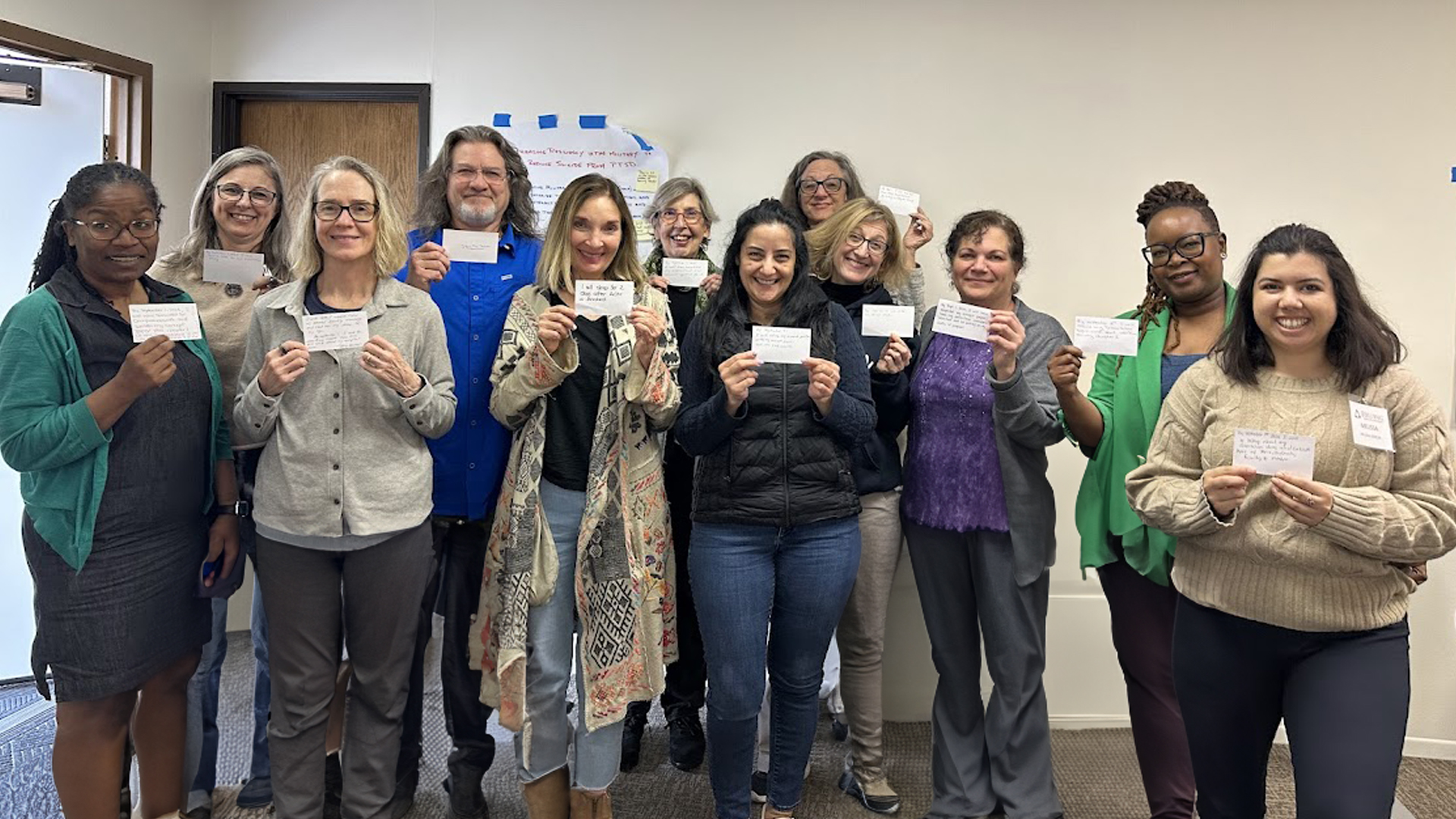CALL FOR PROPOSALS for an upcoming volume in the International Leadership Association’s Women and Leadership Transformative Women Leaders Book Series, Embodied Somatic Leadership for Peacebuilding and Protest: Women’s Counteroffensive to Violence and Injustice. Edited by Randal Joy Thompson and Lazarina Topuzova
“Just as women’s bodies are targeted as weapons of war and social repression, so women use their bodies for peacebuilding and protest.”
Randal Joy Thompson and Lazarina Topuzova are soliciting proposals for their upcoming book Embodied Somatic Leadership for Peacebuilding and Protest: Women’s Counteroffensive to Violence and Injustice. Please see below for a summary of the book and a list of requested submissions and timeline. The editors look forward to receiving a 500-word abstract for any proposed chapter by May 31, 2023 (submission details below).
Description of the Book
The symbolism of the female body has been an obsession of male myth makers, artists, philosophers, and cultural fabricators throughout history. As Susan Onega (2020) wrote, “Parmenides’s division of the cosmos into paired opposites, with woman as the necessary other for the definition of male subjectivity, initiates the symbolization of the female body as monstrous. Prefigured by the nurturing/devouring duality of Mother Earth and mythical women/goddesses like the Medusa, this symbolization expresses the male fear of female sexuality and agency.”
The deep-seated male fear of the female body, its reproductive potential, and its infused nationalist meanings have contributed to violating the female during times of war, terrorism, and even peace. Rape has been a weapon of war since the beginning of history and only after the Bosnian-Serbian war in the 1990s was it considered a war crime. Boko Harem used the female body as a weapon by fashioning over 200 girls and young women, some as young as seven, as suicide bombers to destroy targets throughout Nigeria. Although many other terrorist groups have employed female suicide bombers, Boko Harem’s “use of female minors as human incendiaries [was] geared towards confusing public perception of the imagery of a terrorist as a means of achieving it destructive objective” (Allotey-Pappoe & Agyeiwaa Lamptey, 2019). Rape camps have served as locales for genocide, for eradicating religious and ethnic groups and tribes. Globally, and for epoch after epoch, women’s bodies have been brutalized to destroy their agency and their sexuality under the guise of making them marriageable and desired.
Yet, recognizing the power of their own bodies, women have boldly practiced embodied somatic leadership to bring peace, to protest rape in war, to reconstruct countries after conflict, and to initiate social change. In 2003, Nobel Peace Prize awardee Leymah Gbowee organized women in Liberia to lead through their bodies to force male negotiators to sign a peace agreement to end the civil war in Liberia. They “stepped out and did the unimaginable” by using their bodies to physically prevent peace negotiators from leaving the room in Ghana until they reached an agreement. As Leymah said, “What else do we have to lose? Our bodies are their battlefields: let’s just put our bodies out there” (Tansimore, 2021). In 1993, several young women, many with shrapnel in their bodies, walked across the stage in the Miss Besieged Sarajevo contest. Risking their lives to participate, they carried a banner that read “Don’t let them kill us.” The contest inspired Bono to write a song “Miss Sarajevo” – including the haunting refrain “Here she comes, surreal in her crown” – that he performed with Pavarotti, who sang the lyrics in Italian, building publicity against the siege and action to end it.
Following the end of the Rwandan civil war and genocide in 1994, a collective body of women united to rebuild the country through embodied leadership. From May 1 to 9, 2009, thousands of women in Kenya, including the wives of the Prime Minister and President, went on a “sex strike,” refusing sex with their partners in order to force the Prime Minister and President to show respect and good faith, reconcile, and rule the country after post-election communal violence resulted in over one thousand deaths. The seven day strike ended with a joint prayer session during which the leaders agreed to talk. Women in the community of App in Uganda stripped naked to protest the selling of their land to a South African investor. Seeing a woman one’s mother’s age naked is a curse in Ugandan society so the Minister of Land cried as he witnessed the nudity and the government canceled its scheme.
Women’s organizations in Colombia served as “embodied infrastructures” to help heal victims of sexual violence during the long civil war in Colombia. The 2016 award winning Chinese documentary Hooligan Sparrow illustrated the performative power of the body by depicting the protests of Ye Haiyan and her followers against a professor’s sexual abuse of six young girls. Lin (2018) studied how Ye Haiyan turned her body into a site of struggle and a political resource, how she deployed her body as a weapon to evoke broader emotional and moral resonances, and how she provoked Internet users to spectate, interpret, and imitate her body images, making possible a space of appearance in cyberspace. Women in Kaduna State Nigeria protested naked in 2020 to draw the attention of the government and the public to the murders of their men by Fulani militia and to demand that action be taken to end the killings. In 2022, eight women stood in front of the Russian Embassy in Vilnius in their underwear, bags over their heads, hands tied behind their backs, fake blood running down their legs, to protest the rape by Russian soldiers of Ukrainian women. In 2023, women in Nigeria protested naked in Nasarawa State and in front of the US Embassy in Abuja regarding the fraud and voter tampering in the presidential election.
In each of these examples, women exercised somatic leadership, leadership embodied with the full integration of their minds, souls, and bodies, recognizing their power to change the world. A preliminary definition of embodied somatic leadership is leadership in which intentionality for change, combined with spirit, self, and values is manifested in physical representation.
Protest typically has been represented as “demonstrating against something.” This is a misrepresentation. Protest is “demonstrating for something,” calling for an action, a change, a different reality. Protest is hence leadership in the sense of being a process that influences others to accomplish an objective held by the protesters. Protest is embodied somatic leadership in that the bodies of the protesters represent their intentions, their “stalwart standing for an action or change,” their often quiet determination to stand until the action is taken or the change is made. As Mendez and Mora (2013) argued in their study of the embodied leadership of female Pentecostal pastors:
By careful identification of resistance acts, how they evolve and how they are continuously created through the women’s embodied language, one can begin to identify how resistance practices contribute to the formation of subjectivities and to the development of leadership identities. (p. 131)
Followers may be ignited or even emerge after the women enact embodied somatic leadership and join in the protest, supporting the women’s goal for action and/or change. As Amanda Sinclair (2005) said, “Leadership is a bodily practice, a physical performance in addition to a triumph of mental or motivational mastery. Though leadership works at visceral and sensual levels, activating appetites and desires, this fact has been largely overlooked in most business writing about leadership.” (p. 387)
The Editors seek chapters on a variety of perspectives on women’s embodied somatic leadership. Chapters may, among other things:
1. Highlight women and/or communities of women leaders who employed this leadership approach for peacebuilding and for protest for social justice.
2. Explain why women’s bodies are weapons of war and what this means for the challenges women face.
3. Explain why women’s bodies are critical for leadership in peacebuilding and protest.
4. How followers emerge in the exercise of embodied somatic leadership.
5. Provide a model of embodied somatic leadership.
6. Explain how to develop this leadership approach.
7. Assess the effectiveness of bodily forms of leadership.
8. Explain the use of women’s naked body for peacebuilding and protest.
9. Explain the use of performance and art as bodily leadership for peacebuilding and protest.
10. Cover women who employed this leadership approach to fight for a cause, even a cause that some may be opposed to and even call terrorism, but which the women leaders feel deeply committed to.
11. Explore what this approach means for the status of women and for women’s war in body politics. 12. Discuss other related topics.
About the Editors

Randal Joy Thompson, Ph.D.
Dr. Randal Joy Thompson is a scholar-practitioner with 40 years of professional experience in international development, serving in countries around the world. A Fellow with the Institute for Social Innovation, Fielding Graduate University, her research focuses on the commons, gender, education, evaluation, and organization development. Randal’s published book chapters have covered women leaders in Afghanistan, post-war Bosnia-Herzegovina, Myanmar, and Morocco. She conceived a theory of leadership in international development based on women’s way of knowing and has recently published two articles on violence against women and LGBTQI+ in El Salvador. She is the past President of ILA’s Women and Leadership Community.

Lazarina Topuzova, Ph.D.
Dr. Lazarina Topuzova brings over 15 years of experience teaching and training in the fields of organizational research and program evaluation, diversity, and intercultural communication. Dr. Topuzova holds a Ph.D. in Social Work from the University of Utah. She has an M.A. in American Literature from Sofia University, Bulgaria, and a Masters in Peace and Conflict Resolution from the European Peace University, Austria. Her current research interests and expertise are in developing leadership capacity in community and grassroots organizations, leadership for peace, women in leadership, as well as best practices in online teaching and learning in leadership education. Dr. Topuzova is the former co-editor of the Journal of Hate Studies. She is the current Chair of ILA’s Leadership for Peace Community.
Find out more about the Transformative Women Leaders Series published by Emerald:
https://books.emeraldinsight.com/page/series-detail/transformative-women-leaders/
Submission Procedure:
To be considered, please submit one file to: womenpeacebuildingandprotest@gmail.com on or before May 31, 2023.
Please make your email subject line: Submission – Embodied Somatic Leadership.
Your file should include:
- Your 500-word chapter proposal abstract clearly explaining the mission and concerns of the chapter as well as a list of up to five keywords. Please format your files as follows: Margins should be 1” on all four sides, left-aligned, not justified, Times New Roman, font size 12, double spaced, and indented paragraphs.
- Please include author names and contact information.
- Short narrative bios of each author, illustrating expertise, experience, and/or past engagement with the topics of this book.
- Please name the file with the last name-first name of the first listed author.
Requested Submissions and Timeline:
| Date | Required Submission |
|---|---|
| May 31, 2023 | Authors are requested to submit an abstract up to 500 words describing their proposed chapter. |
| June 16, 2023 | Editors will inform authors whose chapters have been selected for inclusion in the book. |
| December 1, 2023 | Draft Chapters of 3000-4000 words (not including references) should be submitted. |
| December 1, 2023 – January 31, 2024 | Chapters are reviewed by editors and peers. Peers will be asked to review 2 chapters. |
| January 31, 2024 | Feedback provided to authors. |
| March 15, 2024 | Chapter revisions should be submitted in final. |
| March 15, – April 30, 2024 | Co-Editors conduct final review and edits. |
| May 1 – October 30, 2024 | Book production process. |
| October 30, 2024 | Expected publication date. |
Select References
Alexandre, M. (2006). Dance halls, masquerades, body protest and the law: The female body as a redemptive tool against Trinidad’s gender-biased laws. Duke Journal of Gender Law & Policy, 13(1), 177-202. Allotey-Pappoe, S., & Agyeiwaa Lamptey, A. (2019) Pawns, Puppets or Weapons of Choice: Examining Boko Haram’s Use of Female Suicide Bombers in Nigeria. KAIPTC Occasional Paper #42. https://www.kaiptc.org/wp-content/uploads/2020/10/20200901-faar-Final-Occasional-42-Paper-Use-of-Female-Suicide-Bombers.pdf
Bathurst, R., & Cain. T. (2013). Embodied leadership: The aesthetics of gesture. Leadership, 9(3), 358-377. https://doi.org/10.1177/1742715013485
Blomqvist, L., Olivius, L., & Hedström, J. (2021) Care and silence in women’s everyday peacebuilding in Myanmar, Conflict, Security & Development, 21(3), 223-244.
Bohrer, A. (2015). Neoliberalism laid bare: Feminism, intersectionality, and nude protest in the 21st century. Melbourne Journal of Politics, 37. Gale Academic https://link.gale.com/apps/doc/A624519573/AONE?u=anon~28b2a4eb&sid=googleScholar&xid=b198e914
Cardenas, M. L., & Olivius, E. (2021). Building peace in the shadow of war: Women-to-women diplomacy as alternative peacebuilding practice in Myanmar. Journal of Intervention and Statebuilding, 15(3), 347-366.
Fisher, K., & Robbins, C. R. (2015). Embodied leadership: Moving from leader competencies to leaderful practices. Leadership, 11(3), 281 – 299. https://doi.org/10.1177/1742715014522680
Hamill, P. (2013). Embodied leadership: The somatic approach to developing your leadership. Kogan Page.
Kupers, W. E. (2013). Embodied inter-practices of leadership – Phenomenological perspectives on relational and responsive leading and following. Leadership, 9(3), 335 – 357. https://doi.org/10.1177/1742715013485852
Lin, Z. (2018). Individualizing the sexual revolution in China: Staging, enjoying, and experiencing sexuality. Asian Journal of Women’s Studies, 24(4), 446-462. DOI: 10.1080/12259276.2018.1531538
Mathebula, M., & Canham, H. (2022). The affective afterlife of naked body protests. Feminism & Psychology, https://doi.org/10.1177/09593535221120482
Mathebula, M. (2022). Nakedness as decolonial practice. Body & Society. 1-27.
DOI: 10.1177/1357034X221105355
Melina, L. R., Burgess, G., & Marturano, A. (2013). The embodiment of leadership. Jossey-Bass.
Mendez, N., & Mora, F. (2013). Leadership embodiment and resistance: The complex journey of Latin America Pentecostal women pastors. Chapter 7 in L.R.
Medina, G. Burgess, & A. Marturano (Eds.) The Embodiment of Leadership. Jossey-Bass.
Mookherjee, N. (2008). Gendered embodiments: Mapping the body-politic of the raped woman and the nation in Bangladesh. Feminist Review, 88(1), 36-53. https://doi.org/10.1057/palgrave.fr.9400388
Nieto-Valdivieso, Y. F. (2022). Women as embodied infrastructures: Self-led organisations sustaining the lives of female victims of conflict-related sexual violence in Colombia. Journal of Peacebuilding and Development, 17(1), 194-208. DOI: 10.1177/15423166221100428
Onega, S. (2020). The Symbolization of the Female Body in Western Culture from Ancient Greece to the Transmodern Period. In R. Ahrens, F. Klaeger, & K.
Stierstorfer. Symbolism 2020 An International Annual of Critical Aesthetics. https://doi.org/10.1515/9783110716962
Paarlberg-Kvam, K. P. (2016). The key to peace is ours: Women’s peacebuilding in twenty-first century Colombia. A Dissertation Submitted to the University at Albany, State University of New York. ProQuest Dissertations Publishing, 2016. 10246927
Ropo, A., & Salovaara, (2019). Spacing leadership as an embodied and performative process. Leadership, 15(4), 461- 479. https://doi.org/10.1177/1742715018768707
Sinclair, A. (2005). Body possibilities in leadership. Leadership, 1(14), 387-406. DOI: 10.1177/1742715005057231
Sjoberg, L. (2018). Jihadi brides and female volunteers: Reading the Islamic State’s war to see gender and agency in conflict dynamics. Conflict Management and Peace Studies, 35(3), 296-311.
Sugamele, L. (2022). Female body, rape, war: Sexual subjugation of women as a symbol of hegemony and political-national “othering” in the genocide of Bosnia. Fuoiri Luogo Rivista di Sociologia del Territorio, Turismo, Tecnologia – Special Issue Gender (11) 1.
Tansimore, E. (2021). The complicated success of sex strikes. Baker Institute at Juniata College. https://wagingnonviolence.org/baker/2021/09/the-complicated-success-of-sex-strikes-lysistra/
Witton, H. (2022). Women’s bodies in protest (Nudity and Sex Strikes!).
YouTube. https://www.youtube.com/watch?v=FwJYCVfKTwY
Join Over 7,500 Fielding Alumni Located Around The World!
Change the world. Start with yours.™






Get Social